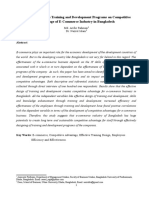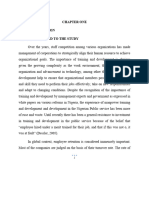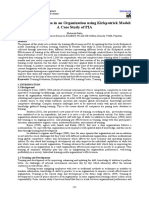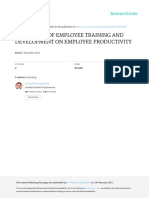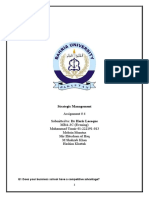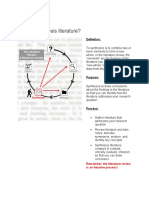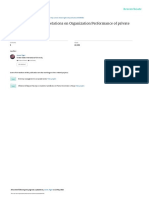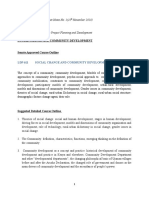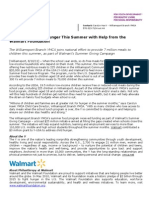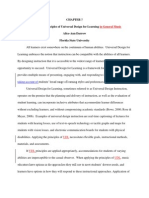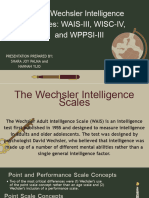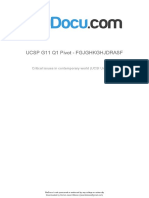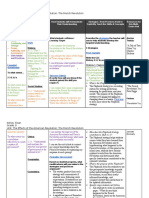Impact of Training and Development On Employee Performance in Retail Sector: A Review Paper
Impact of Training and Development On Employee Performance in Retail Sector: A Review Paper
Uploaded by
Muhammad Umair RajputCopyright:
Available Formats
Impact of Training and Development On Employee Performance in Retail Sector: A Review Paper
Impact of Training and Development On Employee Performance in Retail Sector: A Review Paper
Uploaded by
Muhammad Umair RajputOriginal Description:
Original Title
Copyright
Available Formats
Share this document
Did you find this document useful?
Is this content inappropriate?
Copyright:
Available Formats
Impact of Training and Development On Employee Performance in Retail Sector: A Review Paper
Impact of Training and Development On Employee Performance in Retail Sector: A Review Paper
Uploaded by
Muhammad Umair RajputCopyright:
Available Formats
Impact of Training and development on
Employee Performance in Retail Sector:
A Review paper
Prof. (Dr.) Trilok Kumar Jain,
Director, Ecosystem for Innovation and Entrepreneurship, Suresh Gyan Vihar
University, Jaipur
www.gyanvihar.org email: trilokkr.jain@mygyanvihar.com
tkjainbkn@yahoo.co.in jain.tk@gmail.com
Aditi Sharma
Doctoral Research Scholar, Suresh Gyan Vihar University Jaipur
Email : aditirkl03@gmail.com
Abstract
This is a review paper, based on secondary sources, it is found that training and
development contributes significantly towards performance enhancement on whole in all aspects
of retail companies including customer survey, customer relationship management etc. A large
number of research studies have tried to identify relation between training and developmentand
sales opportunities.
Keywords: retail, sales, training, development, performance, customer, relationship
Introduction
Training and development enhance employee performance and enable companies to
achieve their goals. There have many many studies with regard to training and development a
large number of studies have found that training anddevelopment significantly contribute
towards overall organisational development. Many studies have found training and development
to be contributing towards individual performance enhancement and some have found that there
Electronic copy available at: https://ssrn.com/abstract=3316856
is overall significant increase in the performance of the company due to training and
development. We will look at the significant research findings and insights with regard to this
sector.
Training and Development and Performance Enhancement
In present scenario, training and development is considered to be important element for the
organization to achieve success. The training and development of employees is an issue of
concern for various organizations in present scenario. It is seen that, majority of businesses in
recent past have emphasized on overall personality development of all its employees. According
to Ristow (2009), the business unit with highly skilled and trained employees have more success
rates. Moreover, it is through continuous training and development that effectiveness of
employees improves over a period of time. The training and development programs organized on
part of businesses provide a platform to improve efficiency of the employees. Engle (2008)
claimed that every individual works within organization as per their capabilities and capacities.
The training and development programs provide a way to individuals so as to develop their
capabilities. It can be said that training and development program emphasizes on overall
personality development of individuals. The training and development programs support
business operations and are proved to be effective in nature in range of ways (Strategic Human
Resources Management, 2006). It is through training and development program that employees’
efficiency and capabilities improve. Moreover, the training and development program results in
improving knowledge base and presentation skills of employees. It is seen that some of the
employees need to hand multiple roles. Moreover, they need to organize their tasks in an
efficient manner. The training and development program decides priorities for employees. This
in turn helps them in handling multiple tasks at a time and results in improving employees’
performance. Henceforth, it can be said that the training and development programs are highly
important in nature for the purpose of supporting research work.
According to Denisi, Budwar and Varma (2008), training and development programs
provide the organization an edge over competitors. The organization is able to take advantage of
skilled work-force for maintaining operations. Every business unit tends to continue its
operations with combined efforts of skilled work-force. It is through training and development
programs that the skills of employees can be enhanced. The training and development program
Electronic copy available at: https://ssrn.com/abstract=3316856
helps in moulding employees’ behaviour and efforts in a way that results in achievement of long-
term business objectives (Brown, 2003). The training and development program results in
supporting business efforts of diverting employees’ efforts towards similar goals. It is through
training and development programmes that communication gap between management and
employees reduce. The operations within organization are subject to range of issues. The issues
faced on part of the organization can be resolved by active participation of employees. The
business unit is able to conduct operations in a smooth manner when work-force utilized their
skill and talent in an efficient manner. Fan, (2009), claimed that experienced and skilled
employee is able to provide solution to issues faced on part of the organization without
involvement of many efforts. As per Hafeez and Aburawi (2013), training and development
programmes are considered as tool that helps business unit in number of ways. The ways through
which training and development programmes prove to be effective in nature are discussed below
in detail.
Developing human resources: It is through training and development programmes that the
business unit is able to develop a complete professional and skilled employees. According to
Kearns (2010), training is a tool to produce talented staff from raw individuals. It can be
therefore said that training and development programmes create a platform for development of
efficient work-force within the organization. The human resource is considered you be highly
important element for the success of organization. The trained staff members are considered to
be foundation for smooth operations within business unit. It can be therefore said that the
training and development programs results in development of human resources in an efficient
manner.
Achieving business objectives: In order to achieve short-term and long-term business
objectives, the organization needs to divert efforts of all its employees towards similar goals. It is
through training and development programmes that the business unit is able to clearly
communicate all its objectives to employees (Snell, 2012). Moreover, the training and
development programs help in diverting employees ’efforts toward achievement of business
objectives. According to Youngsoo Choi (2014), employees’ should be motivated towards the
achievement of common goals. The training and development programmes help in bridging the
gap that lies between employees’ interests and business objectives. It can be therefore said that
the business objectives can be achieved when employees are trained in an efficient manner. The
Electronic copy available at: https://ssrn.com/abstract=3316856
skilled and talented work-force ends to create high value for the organization in comparison to
unskilled workforce (Boella and Goss-Turner, 2013). It can be therefore claimed that training
and development programme helps in achievement of business objectives by diverting
employees’ efforts in one direction.
Competitive advantage: The business unit that employs skilled staff tend to have an edge
over its competitors. According to Dimba (2010), organizations with trained and skilled
workforce are expected to perform in an efficient manner. The high level of value creation on
part of skilled workforce is considered to increase competencies of the organization. It can be
therefore said that the training and development programme tends to provide an edge over
competitors. The skilled staff members tend to contribute high value towards the business
operations. In today’s world of competition, the business unit should adopt different strategies
for improving profitability and business performance. The training and development
programmes help in increasing employees’ efficiency. This in turn results in imbibing
operational excellence within the organization (Hafeez, 2013). The highly efficient operation in
turn supports organization’s efforts to fight with competition. It can be therefore said that
training and development program helps in facing competition faced on part of the organization.
It can be therefore said that training and development programmes is a source of competitive
advantage for the business unit into consideration.
Enhancing business performance: The overall business performance is considered to be
highly dependent on employees’ participation. It is through training and development
programmes that the business unit is able to improve organizations’ performance. The skilled
and talented staffs are considered to be valuable resources for the organization (Harris and
Brewster, 2003). The raining and development programmes by improving skills and talent of
employees tend to enhance performance of the organization into consideration. It is through
training that the business unit is able to clarify organization’s requirements among employees
(Fox, 2008). The talented staff members help in improving business performance. It can be
claimed that the training and development programme results in improving business
performance.
It is seen that training and development programmes help in supporting growth and
development of the organization. The organization is expected to maximize the sales by
Electronic copy available at: https://ssrn.com/abstract=3316856
enhancing the efficiency of retail firm. Further, it has been assessed that management enhances
sales of company with the help of highly skilled and expert staff members.
The majority of cash inflow within the organization is in form of revenue. It is through
generation of high level of revenue that profitability within the business unit is increased. It is
seen that businesses in present day motivates employees to keep stake of customers at the top
most priority. It can be therefore said that employees tend to have an impact on revenue earned
on part of the organization.
The retail sector is growing at rapid pace within United Kingdom. It is seen that maximum
of employees within retail unit comprises of sales person. The continuous training and
development programme results in increasing sales opportunities within retail sector. As per
Stockdale and Kühne (2007), it is through training and development programme that the
effectiveness of employees improves in a significant manner. Moreover, direct contact of
employees with that of customers have an impact on brand image of customers. It is continuous
training and development programme that the business unit is able to increase capability of its
organization. The continuous training and development program helps in improving employees’
performance. According to Regis, (2008), the efficiency of employees decides success of
business into consideration. The employees’ efficiency is said to improve overall performance
of businesses into consideration. The business unit is able to achieve long-term growth when its
employees are highly efficient in nature. The revenue that is earned on part of business unit
determines its performance. Haines and Bandth (2002) argued that revenue is earned when
employees are able to convenience customers for making appropriate purchases decision.
Henceforth, the training and development programme is said to impact growth of business unit.
The organization is able to improve employees’ efficiency which in turn results in improving
revenue of the business unit.
The study of Cartwright (2005) has addressed that an effective training system leads
positive impact on the skills and performance of employees within organization from which
organization is able to provide new opportunities to employees related to career growth.
Therefore, retail organization is able to retain efficient employees within business entity so as
management gets appropriate services from staff members for long duration associated with sales
and other departments of company (Analoui, 2007). This approach is seen to play significant role
to revenue of retail organization. As per the study of Boella and Goss-Turner (2013) it has found
5
Electronic copy available at: https://ssrn.com/abstract=3316856
that job satisfaction among employees creates huge impact on the sales and revenue of retail
firm. Author further argued that training influences the capabilities of staff member to handle
different job operations with an appropriate manner that leads positive effect on the perception
employees about different activities of organization. By achieving different tasks within
predetermined time frame through unique skills and knowledge, an employee also gets
recognition for certain work in company. All these factors affect the job satisfaction of workers
along with their morale from which employees provide their best efforts to increase sales of firm
(Zoltners, Sinha and Lorimer, 2008). Therefore, it is seem that training, job satisfaction along
with sales opportunities for company all factors are interlinked with each other.
Ingram and et.al. (2012) has explained that training and development activities within
retail firm increase creativity and learning of various new tactics for product development,
marketing, customer survey, customer handling process etc. It is seem that profitability and sales
of retail organization is greatly influenced by type of products and services offered in retail
business. In addition to that product pricing and quality of goods are creating significant impact
on the purchase decision of consumers. Henceforth, training assists retail firm in order to
promote creativity among employees related to research and development team of company
(Storbacka and et.al., 2009). By using their creativity, they are able to provide some unique
products and services that presents distinct image of company. By offering some unique products
and services, sales opportunities are developed by retail organization.
In this regard, Johnston and Marshall (2013) have evaluated that creativity among staff
members is also playing significant role in formulation and selection of marketing strategies and
tools. By using different skills which has been gained through training along with creativity, staff
members of retail organization is able to create new opportunities for sales through some creative
marketing tactics and managing an appropriate promotional system as per the requirement of
particular. The application of some unique and creative marketing is played vital role to attract
consumers towards the goods and services provided by firm. It is seen that creative marketing
has been considered as a most important factor of organisational success for attainment of
corporate objectives such as development of new opportunities for sales etc (Ristow, 2009). It is
seen in retail sector of UK that different retail firm are using a variety of marketing tools to
increase sales of along with to gain competitive edge over other firms. In this regard, creativity
has enhanced efficiency of employees as well as ability of retail firm to handle tough market
Electronic copy available at: https://ssrn.com/abstract=3316856
conditions. With reference to this evaluation, it can be stated that training helps management of
retail firm to improve efficiency of employees and their capabilities to manage different job
operations with creativity which is essential for organization to establish a distinct image of
products and services in huge market competition (Angle, 2008).
The research of Kulik and Roberson (2008) has addressed that sales of retail organization
is greatly affected by an efficient customer handling process. If retail firm is having an
appropriate customer handling process then management is able to satisfied consumer by
fulfilling their different needs as per a systematic process otherwise consumers are not satisfied
with services of employees. It leads negative impact on sales growth of retail organization. As
per this situation, researcher has further argued that sales opportunities in retail sector and
satisfaction of consumer both are interrelated concepts (Strategic Human Resources
Management, 2006). Henceforth, every business entity associated with retail sector has to
consider relationship between customer satisfaction and sales growth. In this regard, it is seen
that different firms apply several tactics of skills development as per the unique requirements of
sales persons. So, it is stated that training and skills advancement activities within retail
organization increase efficiency and knowledge of employees about different tactics of customer
handling who are belong from different part of society (Budwar and Varma, 2008). Therefore,
employees are able to facilitate best services to consumer as per their distinct requirements. By
assessing needs of consumers and offering appropriate best products as per their special needs,
sales persons can provide best services to consumers and influence their satisfaction level. In this
context, the investigation of Storbacka, Polsa and Sääksjärvi (2011) has addressed that satisfied
consumers is one the most important factor that assists retail organization to establish basis for
future sales. In this regard, customer handling skills of sales executives and other staff members
play most important role in satisfaction of consumers and development of future sales
opportunities.
The employee’s training is termed as one the most important important factor that
influences success and growth of firm in retail sector by maximizing sales opportunities. In this
regard, there are several factors identified associated with staff training which are playing
significant role for development of sales opportunities. In this context, the research of Brown
(2003) has found that communication skills is considered as a most important element of sales
executives within retail organization that leads direct impact on efficiency of employees along
Electronic copy available at: https://ssrn.com/abstract=3316856
with customer handling process. It has been addressed that retail firm is required to provide
personal development training to sales staff from which employees are able to manage
interaction with consumers and superiors with confidence (Fan, 2009). Author further argued
that communication skills enhances ability of sales force to convey the quarries of consumers to
top manager with an appropriate way and resolves issues of consumers in retail store. This
element affects perception of consumers and their buying behaviour that have been considered as
most important factors that maximize the sales opportunities.
The research of Snell (2012) has identified that customer survey is the most important
aspect of retail firm from which companies are able to take views of buyers and understand their
requirement. In this process, management requires to carry out systematic survey in which
employees are playing most vital role. Researcher further evaluated that training provides
assistance to employees in order to handle different operations of customer survey such as
collection of responses and evaluation of data with an appropriate manner. It affects reliability of
outcomes. As per the views of Boella and Goss-Turner (2013) it is stated that an appropriate
customer survey reveals wide range of information about needs and desires of consumers. On the
basis of outcomes market research, retail organization makes change in features, quality and
price of existing products and offers new products (Hafeez and Aburawi, 2013). All these factors
have significantly affected the perception of consumers and developed sales opportunities.
It is seen that goodwill and brand value of retail organization is greatly affected by
complaints and inappropriate sales after services. It also creates negative impact on the future
sales opportunities. In this context, Zoltners, Sinha and Lorimer (2008) have evaluated that after
sales services and handling of customer complaints can be managed with a team of experts
belong from different department. To improve expertise of employees for handling complaints of
consumers, management of retail firm has to schedule different types of training activities as per
the present expertise of employees. Author further argued that staff members must be trained by
top manager or by outside coaching institutions so as quarries and complaints are easily handled
with a systematic manner through emails, calls, website and walk-in etc (Kearns, 2010). An
efficient customer support team with appropriate skills is able to resolve all the issues of
consumers related to products and services. Proper knowledge of customer handling process
assists employees to convey issues of consumers to top manager so as different changes are
implemented in retail organization along with its products (Youngsoo Choi, 2014). This element
Electronic copy available at: https://ssrn.com/abstract=3316856
influences satisfaction level of consumers and develops basis for future sales. Assessment of
quarries and suggestions of consumers also provides assistance to top management to improve
service quality as well as features of products. On the basis of this evaluation, it can be stated
that quality of sales after services is greatly affected by skills of staff members from which
management is able to satisfy all quarries of consumers with an appropriate manner that leads
direct impact future sales opportunities and revenue of company (Ingram and et.al., 2012).
The study of (Dimba, 2010) has determined that employee's training has significantly
affected the morale or motivation level of staff members in the context of retail sector. Further, it
has been assessed that highly motivated staff is played important role to enhance sales of
business entity along with an opportunities for future sales. They and their study have found that
training influences ability and capabilities of staff members for managing various job
operations. In addition to that improvement in skills and efficiency of employees is also provided
new opportunities for career growth within and outside the organization (Harris and Brewster,
2003). All these elements are played vital role to boost up the morale of staff member working in
different departments of retail firm. Furthermore, Storbacka and et.al. (2009) evaluated that
improvement in motivation level of employees’ lead positive impact on individual productivity
and performance of staff such as attainment of sales target, facilitation of best services to
consumers etc. These factors are termed as important motivators that encourage consumers to re-
purchase different products and services of retail firm (Stockdale and Kühne, 2007). With the
help of this factor, management is able create new opportunities future sales.
As per the views of Hafeez (2013)it can be stated that sales of an organization is greatly
affected by marketing and promotional tools which are applied by staff member to attract
consumers in retail sector. In a retail firm, selection and application of different marketing tools
is mainly managed by marketing department or marketing managers (Johnston and Marshall,
2013). By proving new learning of latest marketing tools and practices to employees of
marketing departments through different external conferences and other tactics, top management
of retail firm can apply best and most effective marketing and promotional tools as per the target
consumers (Fox, 2008). In this context, Analoui (2007) further argued that selection of right
promotional tool is very necessary to minimize the expenditure and to maximize the sales. In this
aspect, high trained staff member are played most important role in marketing planning and
selection of different promotional tools that help retail firm to attract new consumers and to
Electronic copy available at: https://ssrn.com/abstract=3316856
maintain loyalty of existing consumers (Boella and Goss-Turner, 2013). Henceforth, it is termed
that application of unique and effective marketing tools is considered as most important part of
business management to generate sales opportunities.
Inference and conclusions
An in-depth research is carried in relation to training and development programmes
employed within business unit and their importance. It is seen that training and development
programmes are beneficial to the organization into consideration in many ways. The analysis of
previous literature indicates that training and development programs are highly important for the
success of the organization. It is seen that literature presented in past shows the manner in which
training and development programmes benefit the organization. It can be claimed that previous
literature has provided valuable insights in relation to significance of training and development
programmes within the organization. However, the literature is unable to establish proper
connection between training programmes and sales opportunities generated within the
organization. Henceforth, it can be said that research gap exists in identifying relationship
between training programmes and sales opportunities generated within business unit.
References:
Analoui, F., 2007. Strategic human resource management. London: Thomson.
Angle, A. D. and et.al., 2008. International Human Resource Management: Managing People in
a Multinational Context. 5th ed. Cengage Learning EMEA.
Boella, M. and Goss-Turner, S., 2013. Human Resource Management in the Hospitality
Industry: a Guide to Best Practice. London: Routledge.
Boella, M. and Goss-Turner, S., 2013. Human Resource Management in the Hospitality
Industry: a Guide to Best Practice. London: Routledge.
Brown, P., 2003. Seeking success through strategic management development. Journal of
European Industrial Training. 27(6). pp.292-303.
Cartwright, S., 2005. Human Resource Management. 2nd ed. Mittal Publications.
Chatha. A. K, Butt. I. and Tariq. A., 2015. Research methodologies and publication trends in
manufacturing strategy: A content analysis based literature review. International Journal of
Operations & Production Management. 35(4). pp.487 - 546.
10
Electronic copy available at: https://ssrn.com/abstract=3316856
Denisi, S. A., Budwar, S. P. and Varma, A., 2008. Performance Management Systems: A Global
Perspective. Taylor & Francis.
Dey. C., 2002. Methodological issues: The use of critical ethnography as an active research methodology.
Accounting, Auditing & Accountability Journal. 15(1). pp.106 - 121.
Dimba, K. B., 2010. Strategic human resource management practices: effect on performance.
African Journal of Economic and Management Studies. 1(2). pp.128-137.
Fan, Q., 2009. Study on the Issue of Staff Training in Business Hotel. IJBM 4(8).
Fox, A., 2008. Get in the business of being green. HR Magazine. 53(6). pp.44-50.
Guercini. S., 2014. New qualitative research methodologies in management. management Decisions.
52(4). pp.662 - 674.
Hafeez, K. and Aburawi, I., 2013. Planning human resource requirements to meet target
customer service levels. International Journal of Quality and Service Sciences. 5(2).
pp.230-252.
Hafeez, K., 2013. Planning human resource requirements to meet target customer service levels.
International Journal of Quality and Service Sciences. 5(2). pp.230-252.
Harris, H. and Brewster C., 2003. International Human Resource Management. CIPD
Publishing.
Ingram, T. N. And et. al., 2012. Sales management: Analysis and decision making. ME Sharpe.
Ingram, T. N. and et.al., 2012. Sales management: Analysis and decision making. ME Sharpe.
Johnston, M. W. and Marshall, G. W., 2013. Sales Force Management: Leadership, Innovation,
Technology. Routledge.
Kearns, P., 2010. HR Strategy. RoutledgeMoss, S. and Hind, G. W. D., 2005. Employability
Skills. Business Education Publishers, Limited.
Kulik, C. T. and Roberson, L., 2008. Common goals and golden opportunities: Evaluations of
diversity education in academic and organizational settings. Academy of Management
Learning & Education. 7(3). pp.309-331.
Lim. M. W. and Ting. H. D., 2013. Research Methodology: A Toolkit of Sampling and Data Analysis
Techniques for Quantitative Research. GRIN Verlag.
Mantri. K. J., 2008. Research Methodology on Data Envelopment Analysis (DEA). Universal-Publishers.
Regis, R., 2008. Strategic Human Resource Management & Development. Excel Books India.
Ristow, L. And et.al., 2009. Human Resource Management. 3rd ed. Juta and Company Ltd.
Smith, A. And et. al., 2004. Delivering customer loyalty schemes in retailing: exploring the
employee dimension. International Journal of Retail & Distribution Management. 32(4).
Pp. 190-204.
Snell, S. A., 2012. Managing Human Resources. Cengage Learning.
Sobh. R. and Perry. C., 2006. Research design and data analysis in realism research. European Journal of
Marketing. 40(11/12). pp.1194 - 1209.
11
Electronic copy available at: https://ssrn.com/abstract=3316856
Storbacka, K. and et.al., 2009.. The changing role of sales: viewing sales as a strategic, cross-
functional process. European Journal of Marketing. 43(7/8). pp.890-906.
Storbacka, K., Polsa, P. and Sääksjärvi, M., 2011. Management practices in solution sales—a
multilevel and cross-functional framework. Journal of Personal Selling & Sales
Management. 31(1). pp.35-54.
Tummons. J., 2014. Using Software for Qualitative Data Analysis: Research Outside Paradigmatic
Boundaries, in Martin Hand , Sam Hillyard (ed.) Big Data? Qualitative Approaches to Digital
Research. 13. pp.155 - 177.
Wilson. S. and MacLean. R., 2011. Research Methods and Data Analysis for Psychology. McGraw-Hill
Higher Education.
Youngsoo Choi, S., 2014. Subjective Well-Being, Work Motivation and Organizational
Commitment of Chinese Hotel Frontline Employees: A Moderated Mediation Study. J
Tourism Res Hospitality. 03(02).
Zoltners, A. A., Sinha, P. And Lorimer, S. E., 2008. Sales force effectiveness: A framework for
researchers and practitioners. Journal of Personal Selling & Sales Management. 28(2).
pp.115-131.
Online
ASDA makes new committment on training. 2015. [Online]. Availaible through:
<http://www.trainingzone.co.uk/topic/asda-makes-new-commitment-training>. [Accessed
on 29th July 2015].
Managing an aging workforce. 2015. [Online]. Availaible through:
<http://www.ceoforum.com.au/article-detail.cfm?cid=7992&t=/Eric-Lesser-IBM-Institute-
for-Business-Value/Managing-an-aging-workforce>. [Accessed on 29th July 2015].
12
Electronic copy available at: https://ssrn.com/abstract=3316856
You might also like
- Q Decision Making MCQDocument12 pagesQ Decision Making MCQcik siti88% (8)
- Jimm Maths ConceptsDocument54 pagesJimm Maths ConceptsMadan Mohan Nimmagadda100% (3)
- Adela C. Licona - Zines in Third Space (2013)Document208 pagesAdela C. Licona - Zines in Third Space (2013)Livia ViganóNo ratings yet
- 45-Hour Parent/Teen Driving Guide: With Freedom Comes Great ResponsibilityDocument56 pages45-Hour Parent/Teen Driving Guide: With Freedom Comes Great Responsibilityjaya bersatuNo ratings yet
- Project On Training and DevelopmentDocument77 pagesProject On Training and DevelopmentPriyanka Yadav89% (9)
- Training Effectiveness Measurement for Large Scale Programs: Demystified!From EverandTraining Effectiveness Measurement for Large Scale Programs: Demystified!No ratings yet
- Bachelor in Education (Tesl) (Hons) February 2021 Research Project (Ers22404) Research ProposalDocument21 pagesBachelor in Education (Tesl) (Hons) February 2021 Research Project (Ers22404) Research ProposalASHWIN 2629No ratings yet
- Survey Questionnaire For Effectiveness of C.A.T.Document2 pagesSurvey Questionnaire For Effectiveness of C.A.T.Celesthiana Rielle100% (2)
- Literature Review of 415Document6 pagesLiterature Review of 415Afridi IslamNo ratings yet
- Internship Report On Training and Development of Employees of Janata Bank LimitedDocument26 pagesInternship Report On Training and Development of Employees of Janata Bank LimitedTareq AlamNo ratings yet
- Employee Training and Development As A Model For oDocument9 pagesEmployee Training and Development As A Model For oThushara VinayNo ratings yet
- Training and DevelopmentDocument11 pagesTraining and DevelopmentAsma hanNo ratings yet
- The Impact of Training and Development On Employee Performance: A Case Study of Allied Bank Limited Lahore City, Punjab, PakistanDocument7 pagesThe Impact of Training and Development On Employee Performance: A Case Study of Allied Bank Limited Lahore City, Punjab, PakistanumalailaNo ratings yet
- Employee Training and Development As A M PDFDocument9 pagesEmployee Training and Development As A M PDFNumra ButtNo ratings yet
- Impact of Effective Training and DevelopDocument14 pagesImpact of Effective Training and Developmuna moono100% (1)
- Question 1Document5 pagesQuestion 1Jill MillerNo ratings yet
- The_Impact_of_Training_and_Development_o (1)Document16 pagesThe_Impact_of_Training_and_Development_o (1)yusrazed2012No ratings yet
- A Study On Impact of Training Program On Employee ProductivityDocument6 pagesA Study On Impact of Training Program On Employee Productivityluthu paduNo ratings yet
- Chapter 1-5 AgunloyeDocument45 pagesChapter 1-5 Agunloyemendozadorothy80No ratings yet
- Impact of Training On Employees Performance in Manufacturing IndustriesDocument45 pagesImpact of Training On Employees Performance in Manufacturing IndustriesABDULRAZAQNo ratings yet
- Training Evaluation in An Organization Using Kirkpatrick Model: A Case Study of PIADocument11 pagesTraining Evaluation in An Organization Using Kirkpatrick Model: A Case Study of PIADita HendraniNo ratings yet
- The Relationship Between Employee Training and Development and Organisational Performance An Empirical StudyDocument9 pagesThe Relationship Between Employee Training and Development and Organisational Performance An Empirical StudynatiNo ratings yet
- Human Resource Management Individual Assignment OnDocument12 pagesHuman Resource Management Individual Assignment OnniravNo ratings yet
- RESEARCH PROPOSAL IN HRM and Industrial RelationsDocument12 pagesRESEARCH PROPOSAL IN HRM and Industrial RelationsKELVIN KHOLOMANo ratings yet
- Chapter - I Training and DevelopmentDocument62 pagesChapter - I Training and DevelopmentDinesh BabuNo ratings yet
- Assignment 2 Essay (ERD)Document9 pagesAssignment 2 Essay (ERD)RubahdeviAngelNo ratings yet
- Running Head: The Importance of Training and Development 1Document6 pagesRunning Head: The Importance of Training and Development 1cynthiaNo ratings yet
- Evaluating Training & Development Effectiveness - A Measurement ModelDocument14 pagesEvaluating Training & Development Effectiveness - A Measurement Modeldharshn12345No ratings yet
- Theoretical Framework On The Effectiveness of Training & Development - "Review of Literature "Document12 pagesTheoretical Framework On The Effectiveness of Training & Development - "Review of Literature "Tesfaye AdugnawNo ratings yet
- The Need For Employees Training and Development in An OrganizationDocument17 pagesThe Need For Employees Training and Development in An OrganizationTom NaveenNo ratings yet
- Training and Development Program and Its Benefits To EmployeeDocument12 pagesTraining and Development Program and Its Benefits To EmployeeDirgo WicaksonoNo ratings yet
- Nramzey Final Paper SubmissionDocument25 pagesNramzey Final Paper Submissionapi-288152974No ratings yet
- HRD Assignment 1 2017011861 Mayamba ImakandoDocument13 pagesHRD Assignment 1 2017011861 Mayamba Imakandomayamba imakandoNo ratings yet
- Research Article ISSN 2221Document4 pagesResearch Article ISSN 2221Irene KangNo ratings yet
- A Project Report On Training and Development of Employees at TATA MOTORS LIMITEDDocument11 pagesA Project Report On Training and Development of Employees at TATA MOTORS LIMITEDmithamadhu4545No ratings yet
- The Role of Training in The Development of Employees PerformanceDocument19 pagesThe Role of Training in The Development of Employees PerformanceZaid ALshaalan100% (2)
- Thesis Training Course PracticesDocument2 pagesThesis Training Course PracticesAlmera Flores LibresNo ratings yet
- Research ProposalDocument36 pagesResearch Proposaltaimur100% (1)
- The Impact of Employee Training and Development On EmployeeDocument4 pagesThe Impact of Employee Training and Development On Employeeadi0077No ratings yet
- HPM7202 Individual Assignment PBS21101107 - Nizzam 2Document31 pagesHPM7202 Individual Assignment PBS21101107 - Nizzam 2Azdzharulnizzam AlwiNo ratings yet
- Final Project Report On Training and DevelopmentDocument86 pagesFinal Project Report On Training and DevelopmentManpreet Kaur100% (2)
- TDPandits BenefitsDocument12 pagesTDPandits BenefitsShikha sharmaNo ratings yet
- The Impact of Training and Development On Employee Job PerformanceDocument19 pagesThe Impact of Training and Development On Employee Job PerformanceMULUSEW EJIGUNo ratings yet
- Impact of Training and Development On Employee Retention in Nepalese Commercial BanksDocument32 pagesImpact of Training and Development On Employee Retention in Nepalese Commercial BanksAmrit ShresthaNo ratings yet
- RetrieveDocument15 pagesRetrieveKatherine LinNo ratings yet
- Patil Sushmitha MB181302 SYNOPSISDocument20 pagesPatil Sushmitha MB181302 SYNOPSISSunder RajNo ratings yet
- The Impact of Employee Training and Development On Employee ProductivityDocument4 pagesThe Impact of Employee Training and Development On Employee ProductivityAsark 99No ratings yet
- Karim DKK (2019)Document9 pagesKarim DKK (2019)Khairuman NawawiNo ratings yet
- The Impact of Employee Training and Development On EmployeeDocument4 pagesThe Impact of Employee Training and Development On EmployeehinaNo ratings yet
- The Need For Employees Training and Development in An OrganizationDocument17 pagesThe Need For Employees Training and Development in An OrganizationGuna SekaranNo ratings yet
- Chapter One & Two Human Resource PlanningDocument25 pagesChapter One & Two Human Resource PlanningMentorNo ratings yet
- Impact of Training On Employee Performance: A Case Study of Private Organization in Sri LankaDocument9 pagesImpact of Training On Employee Performance: A Case Study of Private Organization in Sri LankaKrishna MishraNo ratings yet
- Research Design and Execution of The StudyDocument74 pagesResearch Design and Execution of The StudyhonoureengomesNo ratings yet
- Effectsof Trainingon Organizational PerformanceDocument11 pagesEffectsof Trainingon Organizational PerformanceZeyar Myo MonNo ratings yet
- Strategic Training and Development: The Impact On Employees' PerformanceDocument5 pagesStrategic Training and Development: The Impact On Employees' Performanceniazibro786No ratings yet
- Assignment 1 Research ProjectDocument25 pagesAssignment 1 Research ProjectRoni AliNo ratings yet
- Application of Business Research: Adnan KhanDocument11 pagesApplication of Business Research: Adnan KhanMalik Mughees AwanNo ratings yet
- ChapterDocument59 pagesChapterjuliessahawa872No ratings yet
- Emerging Organisational Trends in Training & Development in IndiaDocument5 pagesEmerging Organisational Trends in Training & Development in IndiaSubrat RathNo ratings yet
- The Impact of Training and Development On Organizational PerformanceDocument6 pagesThe Impact of Training and Development On Organizational PerformanceMuhammad Asad88% (24)
- MANI Project PDFDocument82 pagesMANI Project PDFrajeswarinisha4No ratings yet
- Evaluation ModelsDocument12 pagesEvaluation ModelsNkvNo ratings yet
- Literature Review On Employee Training and DevelopmentDocument13 pagesLiterature Review On Employee Training and DevelopmentMizanur Rahman Peash100% (1)
- Learning and Development: How To Close The Skills Gap in Your OrganizationFrom EverandLearning and Development: How To Close The Skills Gap in Your OrganizationNo ratings yet
- The Ultimate Employee Training Guide- Training Today, Leading TomorrowFrom EverandThe Ultimate Employee Training Guide- Training Today, Leading TomorrowNo ratings yet
- SM Air Industry and Porter 5 ForcesDocument7 pagesSM Air Industry and Porter 5 ForcesMuhammad Umair RajputNo ratings yet
- Experience LetterDocument1 pageExperience LetterMuhammad Umair RajputNo ratings yet
- Typical Interview Questions: Question #1: What Do You Know About Our Organization?Document6 pagesTypical Interview Questions: Question #1: What Do You Know About Our Organization?Muhammad Umair RajputNo ratings yet
- Project Management Practical Implication Issues of Project Management in Oil and Gas Development Company Limited (OGDCL) PakistanDocument3 pagesProject Management Practical Implication Issues of Project Management in Oil and Gas Development Company Limited (OGDCL) PakistanMuhammad Umair RajputNo ratings yet
- Assignment 4Document5 pagesAssignment 4Muhammad Umair RajputNo ratings yet
- SM IKEA AssignmentDocument2 pagesSM IKEA AssignmentMuhammad Umair RajputNo ratings yet
- Synthesize What Is Synthesis Literature?: DefinitionDocument1 pageSynthesize What Is Synthesis Literature?: DefinitionMuhammad Umair RajputNo ratings yet
- In Uence of Employee Relations On Organization Performance of Private Universities in KenyaDocument29 pagesIn Uence of Employee Relations On Organization Performance of Private Universities in KenyaMuhammad Umair RajputNo ratings yet
- Role of Literature ReviewDocument10 pagesRole of Literature ReviewMuhammad Umair RajputNo ratings yet
- M N SrinivasDocument5 pagesM N SrinivasSandeep Kumar Meena100% (2)
- LDP 611 Social Change-Lecture 1-11Document147 pagesLDP 611 Social Change-Lecture 1-11AludahNo ratings yet
- 2013 Metodine Priemone Comparative Politics PDFDocument150 pages2013 Metodine Priemone Comparative Politics PDFmirhafeez100% (2)
- Full Download Emergency Imaging of At-Risk Patients: General Principles 1st Edition Michael N. Patlas PDFDocument64 pagesFull Download Emergency Imaging of At-Risk Patients: General Principles 1st Edition Michael N. Patlas PDFgyekyeikoka81100% (3)
- (Download PDF) Week by Week Plans For Documenting Childrens Development 7Th Edition Barbara Ann Nilsen Full Chapter PDFDocument69 pages(Download PDF) Week by Week Plans For Documenting Childrens Development 7Th Edition Barbara Ann Nilsen Full Chapter PDFriccachanik55100% (9)
- Walmart Press ReleaseDocument1 pageWalmart Press Releaserob_crowell_1No ratings yet
- Global Marketing Management Assignment 1 BriefDocument5 pagesGlobal Marketing Management Assignment 1 Briefadibirla15No ratings yet
- 3is Class Note (Lesson 5)Document8 pages3is Class Note (Lesson 5)Jun Elbert JaboliNo ratings yet
- Dr. Love's 5 Step Plan For Reconciling With Your Ex: by Dr. Jamie TurndorfDocument18 pagesDr. Love's 5 Step Plan For Reconciling With Your Ex: by Dr. Jamie TurndorfTḮṯṏ ĐēṽĭļĦĕåřŧ100% (1)
- Islamic Criminal LawDocument4 pagesIslamic Criminal LawRaudah RaisNo ratings yet
- DR Darrow Book ChapterDocument32 pagesDR Darrow Book Chapterapi-242544177No ratings yet
- Learning TheoriesDocument27 pagesLearning TheoriesJay-r Blanco67% (3)
- Top 20 Engineering Colleges in AP (Andhra Pradesh)Document3 pagesTop 20 Engineering Colleges in AP (Andhra Pradesh)varaNo ratings yet
- MW2063 - Malawi Vision 2063 DocumentDocument92 pagesMW2063 - Malawi Vision 2063 DocumentSitwell Chichitike BandaNo ratings yet
- CV Arif Rohman (2024)Document3 pagesCV Arif Rohman (2024)Arif Rohman PembangunNo ratings yet
- Rich Dad's Cashflow Quadrant - Robert T. KiyosakiDocument89 pagesRich Dad's Cashflow Quadrant - Robert T. Kiyosakihipnoza.ezoterica.roNo ratings yet
- The Wechsler IntelligenceDocument41 pagesThe Wechsler IntelligenceCheasca AbellarNo ratings yet
- Himayat Doon School Magazine #Document5 pagesHimayat Doon School Magazine #Puneet SabharwalNo ratings yet
- Ucsp PivotDocument76 pagesUcsp PivotRomel Jasen BibosoNo ratings yet
- Communicative EnglishDocument5 pagesCommunicative EnglishDhugaan Galgalaaf100% (1)
- Placement Brochure 2 0 1 7 - 1 9: M.Sc. ForestryDocument13 pagesPlacement Brochure 2 0 1 7 - 1 9: M.Sc. ForestryRaja Vamsi MavuduruNo ratings yet
- Comunitatea Din AndrieseniDocument5 pagesComunitatea Din AndrieseniMarius ConstantinNo ratings yet
- Curriculum Map 1Document11 pagesCurriculum Map 1api-349798271100% (1)
- Sara Berrios Alguera - Level 11 HW4Document3 pagesSara Berrios Alguera - Level 11 HW4saraberriosal123No ratings yet














